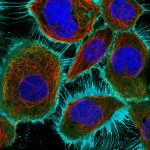Link to Pubmed [PMID] – 36597754
Link to DOI – 10.1111/boc.202200085
Biol Cell 2023 Jan; ():
The Human Immunodeficiency Virus type 1 (HIV-1) is an intracellular pathogen whose replication cycle strictly depends on the host cell molecular machinery. HIV-1 crosses twice the plasma membrane, to get in and to get out of the cell. Therefore, the first and the last line of intracellular component encountered by the virus is the cortical actin network. Here, we review the role of actin and actin-related proteins in HIV-1 entry, assembly, budding and release. We first highlight the mechanisms controlling actin polymerization at the entry site that promote the clustering of HIV-1 receptors, a crucial step for the virus to fuse with the plasma membrane. Then, we describe how actin is transiently depolymerized locally to allow the capsid to cross the actin cortex, before migrating toward the nucleus. Finally, we review the role of several actin-binding proteins in actin remodeling events required for membrane deformation and curvature at the viral assembly site as well as for virus release. Strikingly, it appears that common actin-regulating pathways are involved in viral entry and exit. However, while the role of actin remodeling during entry is well understood, this is not yet the case during exit. We discuss remaining challenges regarding the actin-dependent mechanisms involved in HIV-1 entry and exit, and how they could be overcome. This article is protected by copyright. All rights reserved.



